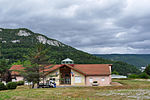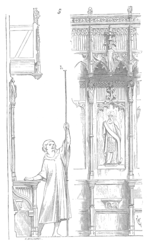Condat Abbey was founded in the 420s in the valley of Bienne, in the Jura mountains, in modern-day France. Condat became the capital of Haut Jura. The founders were local monks, Romanus (died c. 463), who had been ordained by St. Hilary of Arles in 444, and his younger brother Lupicinus of Lyon (Lupicin); the easily defended isolated site they chose for the separate cells in which they and their followers would live in emulation of the Eastern manner of the Desert Fathers was on a stony headland at the confluence of the rivers Bienne and Tacon. Though the site still contained Roman ruins, it was accounted a 'desert' in the Life of the Fathers of the Jura, which contains the early saint's lives. Romanus continued founding other abbeys, such as Romainmôtier Abbey at Romainmôtier-Envy, which retains his name. Not far away at La Balme, Yole, the sister of Romanus and Lupicinus, founded her nunnery.
The establishment at Condat developed into one of the pre-eminent monasteries of the Merovingian and Carolingian eras. The fourth abbot, Eugendus (Oyend, died c. 510–515), was educated in the monastery and never left it. As abbot he rebuilt it in stone and transformed its early eremitism to a coenobitic rule. Oyend increased the independence of the monastery and transformed it into an ecclesiastical principality that ruled all Upper Jura; nevertheless, the diplomas apparently from Charlemagne and confirming territorial rights were demonstrated by René Poupardin to be forgeries, apparently of the eleventh century. After the time of Oyend, the monastery at Condat and the village that developed around its protective walls were known as Saint-Oyend-de-Joux. From Oyend's abbey and from Lérins Sigismund of Burgundy, newly converted from Arianism, drew monks for the refounded house (St. Maurice's Abbey) that he established at Agaunum, c. 515–522. Many further abbots of Condat were canonised, as well as several monks of the sixth and seventh centuries.
The abbey library and school educated Leutfridus (Leufroy, died 738) himself a founder of a Benedictine abbey, Romanus, Archbishop of Reims, and Viventiolus, Archbishop of Lyon. Carloman, uncle of Charlemagne, retired to Condat, where the Benedictine rule was established in 814. A monk of Condat, Manon, having enriched the library of Condat with manuscripts, was appointed by Charles the Bald, about 874, to head the Palace school: among his pupils there was Radboud, Bishop of Utrecht.In the tenth century Stephen of Beze (died 1116) increased the abbey's reputation. Before he became a monk of Condat, Simon of Crépy, of the Carolingian royal house, was raised by Matilda, wife of William the Norman, was made count of Valois and Vexin, and fought Philip I of France. Condat Abbey was a member of the Holy Roman Empire, held directly from the Emperor and independent of the Count of Burgundy. By the late twelfth century it possessed thirty-four priories, 108 churches and twenty-seven chapels.Its famed collection of relics of the local saints drew pilgrims. In the twelfth century the body of the twelfth abbot, Claudius of Besançon (Claude, died 699), was exhumed intact and proclaimed a miraculous relic with curative powers. The cultus of Saint Claude that soon developed, extended to the pious king, Louis XI.







